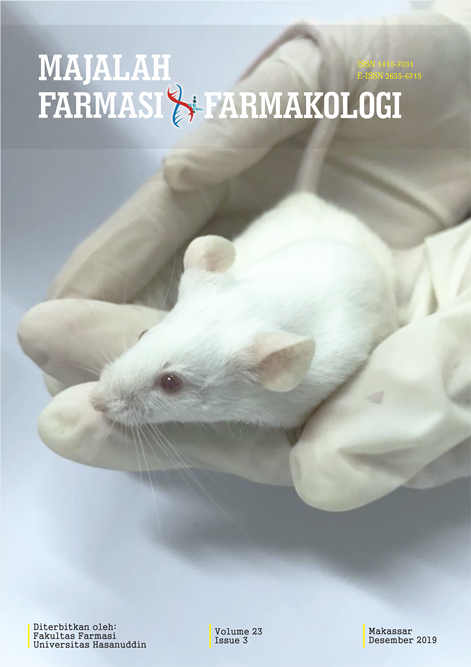MIKROENKAPSULASI ASAM MEFENAMAT MENGGUNAKAN POLIMER HIDROKSI PROPIL METIL SELULOSA DAN NATRIUM ALGINAT DENGAN METODE GELAS IONIK
Abstract
Asam mefenamat bersifat rentan terhadap cahaya maupun terhadap udara dan kelembaban. Selain itu asam mefenamat memiliki waktu paruh yang sempit, dapat menyebabkan peningkatan resiko gangguan gastrointestinal termasuk iritasi lambung pada penggunaan jangka panjang. Teknologi Mikroenkapsulasi merupakan proses penyalutan bahan aktif berupa cairan ataupun padatan dengan lapisan yang relatif tipis dengan ukuran partikel yang sangat kecil antara 0,2-5000 μm. Tujuan penelitian ini untuk melakukan preparasi mikroenkapsulasi terhadap asam mefenamat menggunakan polimer Hidroksi Propil Metil Selulosa (HPMC) dan Natrium alginat dengan metode gelasi ionik lalu mengkarakterisasi hasil mikrokapsul yang diperoleh. Preparasi mikroenkapsulasi dilakukan dengan membandingkan konsentrasi polimer yang digunakan, dibuat dalam 3 formula. Parameter karakterisasi meliputi penetapan efisiensi penjerapan, distribusi ukuran partikel, bentuk partikel dan pengujian disolusi. Hasil karakterisasi menujukan mikroenkapsulasi Asam Mefenamat yang dihasilkan memiliki bentuk partikel yang spheris, dengan nilai efisiensi penjerapan terbesar yaitu 67,53% untuk perbandingan HPMC dan natrium alginat masing-masing 4 : 1, sedangkan distribusi ukuran partikel bervariasi dengan ukuran terkecil yakni 1.105 , untuk hasil pengujian disolusi pada medium asam diperoleh konsentrasi pelepasan obat terbesar adalah 10,39 mg/L dan medium basa sebesar 74,456mg/mL. Penelitian Hasil penelitian ini menunjukkan bahwa asam mefenamat dapat dipreparasi dengan teknik mikroenkapsulasi sehingga dapat mengatasi beberapa kekurangan asam mefenamat.References
Patel, M.J., Patel,N.M., Patel, R.B., Dan Patel R,P. (2010) Formulation And Evaluation Of Self-Microemulsifying Drug Delivery System Of Lovastatis, Asian. J. Pharm. Vol 5(6):266-275.
Indrawati, T., dan Sari, N.K. (2010) Stabilitas Kap;Et Asam Mefenamat Dengan Suhu Dan Kelembapan Ruang Penyimpanan yang Berbeda. Makara Kesehatan. Vol. 14(2):75-80.
Jyothi, N.V.N.,P. Muthu. P.,Suhas, N.S.,K Surya, P., P.P Seetha, R., dan G. Y Srawan. (2010) Microencapsulation Techniques, Faktor Influenching Encapsulation Efficiecy. Journal Of Microencaptulation. Vol 27. No. 3.
Firdyawati. (2014) Skripsi: Formulasi Mikropartikel Teofilin Menggunakan PenyalutKitosan-Alginat Yang Dipaut Silang dengan NatriumTripolifosfat.
Launer, C. Dan Jenifer, D. (2000) Review Article, Improving Drug Solubility For Oral Dlivery Using Dispersions. European Journal Of Pharmaucetics And Biopharmaucetics, 50,47-60.
Kuen Yong., David J. Mooney. (2012) Alginate: Properties and biomedical applications. Elsevier
Chowdary And Madhavi. (2011) Preparation And Evaluation Of Hpmc-Alginate Mucoadhesive Microcapsules Of Diclofenac For Controlled Release, IJPSR. Vol. 2(11): 2801-2805
Handayani, I. (2008) Karakterisasi dan Profil Disolusi Atenol Dari Matriks Kompleks Poliion Kitosan-Natrium Alginat. Fakultas Matematika Dan Ilmu Pengetahuan Alam Departemen Farmasi. Universitas Indonesia. Depok.
Trisnawati, A.R., dan Sari, E.C., 2014. Enkapsulasi Pirazinamid Menggunakan Alginat-Kitosan dengan Variasi Konsentrasi Penambahan Surfaktan Tween 80. UNESA Journal of Chemistry. Vol.3 (3).
Rao, A,P., dkk, 2011. Preparation and Evaluation Of Muchoadesive Microcapsules Of Ibu Profen For Controllled release. International Research Journal Of Pharmacy. Vol 2(5): 257-260.
Utama, D.A., Esti, H., dan Dewi, M.H., 2013. Pengaruh Kecepatan Pengadukan Terhadap Karakteristik Fisik Mikrosfer Ovalbumin-Alginat Dengan Metode Aerosolisasi. PharmaScientia. Vol.2(2).
Noviza1 D , Tita H dan Ade A.R, 2013, Mikroenkapsulasi Metformin Hidroklorida Dengan Penyalut Etilsellulosa Menggunakan Metoda Penguapan Pelarut, Jurnal Sains dan Teknologi Farmasi, Vol.18(1) :ISSN : 1410-0177.
Kurniawan, R., Dan Deni R., 2015. Mikroenkapsulasi Controlled Release Lansoprazol Dengan Kombinasi Hydroxy Propil Methyl Cellulose Phathalate Dan Natrium Alginat Secara Gelasi Iontropik. Jurnal Ilmu Kefarmasian Indonesia. Vol. 14(1): ISSN 1693-1381.
Srifiana, Yudi. 2014. “Mikroenkapsulasi Ketoprofen dengan Metode Koaservasi Menggunakan Pragelatinisasi Pati Singkong dan Metode Semprot Kering Menggunakan Pragelatinisasi Pati”. Skripsi. Depok: Fakultas Farmasi Program Studi Magister Ilmu Kefarmasian. Universitas Indonesia
Findia, P., Sari Edi Cahyaningrum. (2014) Enkapsulasi Pirazinamid Menggunakan Alginate Dan Kitosan. UNESA Journal Of Chemistry. Vol 3(3).
Kasih, N. (2014) Skripsi. Formulasi Dan Karakterisasi Mikropartikel Ektrak Etanol 50% Kult Buah Manggis (Garcinia Mangostana L.) Dengan Metode Semprot Kering (Spray Drying).
Balla, A., Dr. Shivanand Kalyanappa., Haarika Maddineni., Ashvini H.M. (2014) Formulation And In Vitro Evaluation Of Microparticle Carrier Containing Mefenamic Aci, World Journal Of Pharmacy And Pharmaceutical Sciences. Vol. 3(3): ISSN 2278 – 4357. Bogor: FMIPA UI, 2008
Rowe, R.C., Paul, J.S., dan Marian, E.Q., 2009, Handbook pf Pharmaceutical Excipients Sixth Editio, Chicago, London: Pharmaceutical Press
Bolourtchian, N., Karimi, K., Aboofazeli, R., 2005. Preparation and characterization of ibuprofen microspheres. Journal of Microencapsulation. Vol. 22 :529–538.
Herdini, Latifah, K.D., dan Purwantiningsih, S. (2010). Disolusi Mikroenkapsulasi Kurkumin Tersalut Gel Kitosan-Alginat-Glutaraldehida. Makara Sains. Vol. 14 (1)
Downloads
Published
Issue
Section
License
The copyright to this article is transferred to Universitas Hasanuddin (UNHAS) if and when the article is accepted for publication. The undersigned hereby transfers all rights in and to the paper including without limitation all copyrights to UNHAS. The undersigned hereby represents and warrants that the paper is original and that he/she is the author of the paper, except for material that is clearly identified as to its original source, with permission notices from the copyright owners where required. The undersigned represents that he/she has the power and authority to make and execute this assignment.
We declare that:
- This paper has not been published in the same form elsewhere.
- It will not be submitted anywhere else for publication prior to acceptance/rejection by this Journal.
- A copyright permission is obtained for materials published elsewhere and which require this permission for reproduction.
Furthermore, I/We hereby transfer the unlimited rights of publication of the above-mentioned paper in whole to UNHAS The copyright transfer covers the exclusive right to reproduce and distribute the article, including reprints, translations, photographic reproductions, microform, electronic form (offline, online) or any other reproductions of similar nature.
The corresponding author signs for and accepts responsibility for releasing this material on behalf of any and all co-authors. This agreement is to be signed by at least one of the authors who have obtained the assent of the co-author(s) where applicable. After submission of this agreement signed by the corresponding author, changes of authorship or in the order of the authors listed will not be accepted.


